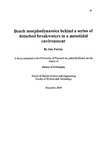Beach morphodynamics behind a series of detached breakwaters in a mesotidal environment
| dc.contributor.author | Fairley, Iain Alastair | |
| dc.contributor.other | Faculty of Science and Engineering | en_US |
| dc.date.accessioned | 2011-05-13T13:27:31Z | |
| dc.date.available | 2011-05-13T13:27:31Z | |
| dc.date.issued | 2009 | |
| dc.identifier | Not available | en_US |
| dc.identifier.uri | http://hdl.handle.net/10026.1/472 | |
| dc.description.abstract |
Morphodynamics of beaches protected by detached breakwaters have been investigated in this thesis at timescales ranging from days to years. A site consisting of nine breakwaters on a coast open to energetic wave conditions in a meso-tidal environment is studied. Two phases of breakwaters were built at the site: phase one comprising of four fully emergent, 200m long structures, which have caused the formation of tidal tombolos; and phase two, five 160m long breakwaters, submerged at high tide, behind which salients have formed. The site allows for comparison of response at beaches protected by different breakwater designs under similar wave and tidal forcing. Three analysis strands are presented: video derived intertidal changes; differential global positioning system (DGPS) surveys; and numerical modelling of the breakwater scheme. Together, the three strands allow for determination of important changes to beach morphology and their relation to forcing. A dataset of weekly mean sea level contours and a set of pre- and post- storm inter-tidal surveys were extracted from the video data. DGPS surveys were conducted of the beach and the inshore bathymetry at monthly intervals; these allowed definition of supra- and sub-tidal changes not achievable from the video data. A `state of the art' numerical model, MIKE21, was used to model waves, hydrodynamics and sediment transport about the scheme for prevailing boundary conditions. The numerical modelling gave insight into the sediment transport pathways and the relative importance of waves and tides as driving forces for morphological change. The beaches protected by the breakwaters were found to be eroding at an average rate of 0.5m yr'' (vertical elevationc hange),a rate comparablet o unprotectedb eachesT. hus it seemst he detached breakwater scheme is failing to substantially reduce the local erosion problem. The dynamic natureo f the beachese, speciallyt he tombolos and salients,m eanst hat an equilibrium shorelinec annotb e establishedT. he breakwaterp rotectedb eachesw ere less variable than the unprotectedb eachesd, isplaying 65-75% of the standardd eviation of vertical change.H owever, morphological changesw ere still considerable:r angei n cross-shorem ovemento f the means ea level contour was between 6m in the bay centres and 80m on the tombolo horns. Empirical orthogonal function analysis of the DGPS and mean sea level contour datasets allowed for determination of three main modes of change which were similar for both phases. The changes were: a general erosion and accretion (46-75% of the dataset variance), a longshore movement of the salients and tombolos (6-27% of the dataset variance), and cross-shore profile changes (-10% of the dataset variance). Correlation analysis and consideration of the numerical modelling results and storm induced morphological change provided relation of the observed changes to wave and tidal forcing. Differences in morphological response were noted for the different breakwater designs. Patterns of response behind the larger breakwaters were better defined due to higher gradients in wave energy between sheltered and unsheltered regions. Cross-shore changes displayed additional three-dimensionality for the smaller breakwaters which led to an increase and decrease in the amplitude of salient sinuosity. An additional mode of change, sub-tidal erosion and accretion of the bay floors, was observed for the larger breakwaters. Temporal signals showed more seasonality for the phase two breakwaters. In summer the beaches protected by the smaller breakwaters were wider, higher and salient amplitudes were greater. The changes behind the phase one breakwaters exhibited greater dependence on specific wave and surge events. The general erosion and accretion showed an eroding trend with erosion exacerbated by higher water levels for beaches protected by both sizes of breakwater. The longshore movement of the tombolos and salients was forced by obliquely incident waves. For the tombolos, numerical modelling also demonstrated the importance of tidally induced movement. Magnitude of longshore movement (typically -'25m) depended strongly on the antecedent morphological conditions. Cross-shore profile changes were storm induced for the beaches protected by the larger structures: storms reducing profile gradients rapidly and subsequent poststorm recovery. For the beaches protected by the smaller structures, storm induced gradient changes were also important but an additional correlation with wave period was noted. The sub-tidal changes to the phase one bay floors were forced by storm and surge conditions. | en_US |
| dc.description.sponsorship | the Engineering and Physical Sciences Research Council | en_US |
| dc.language.iso | en | en_US |
| dc.publisher | University of Plymouth | en_US |
| dc.title | Beach morphodynamics behind a series of detached breakwaters in a mesotidal environment | en_US |
| dc.type | Thesis | |
| dc.identifier.doi | http://dx.doi.org/10.24382/3949 |
Files in this item
This item appears in the following Collection(s)
-
01 Research Theses Main Collection
Research Theses Main


